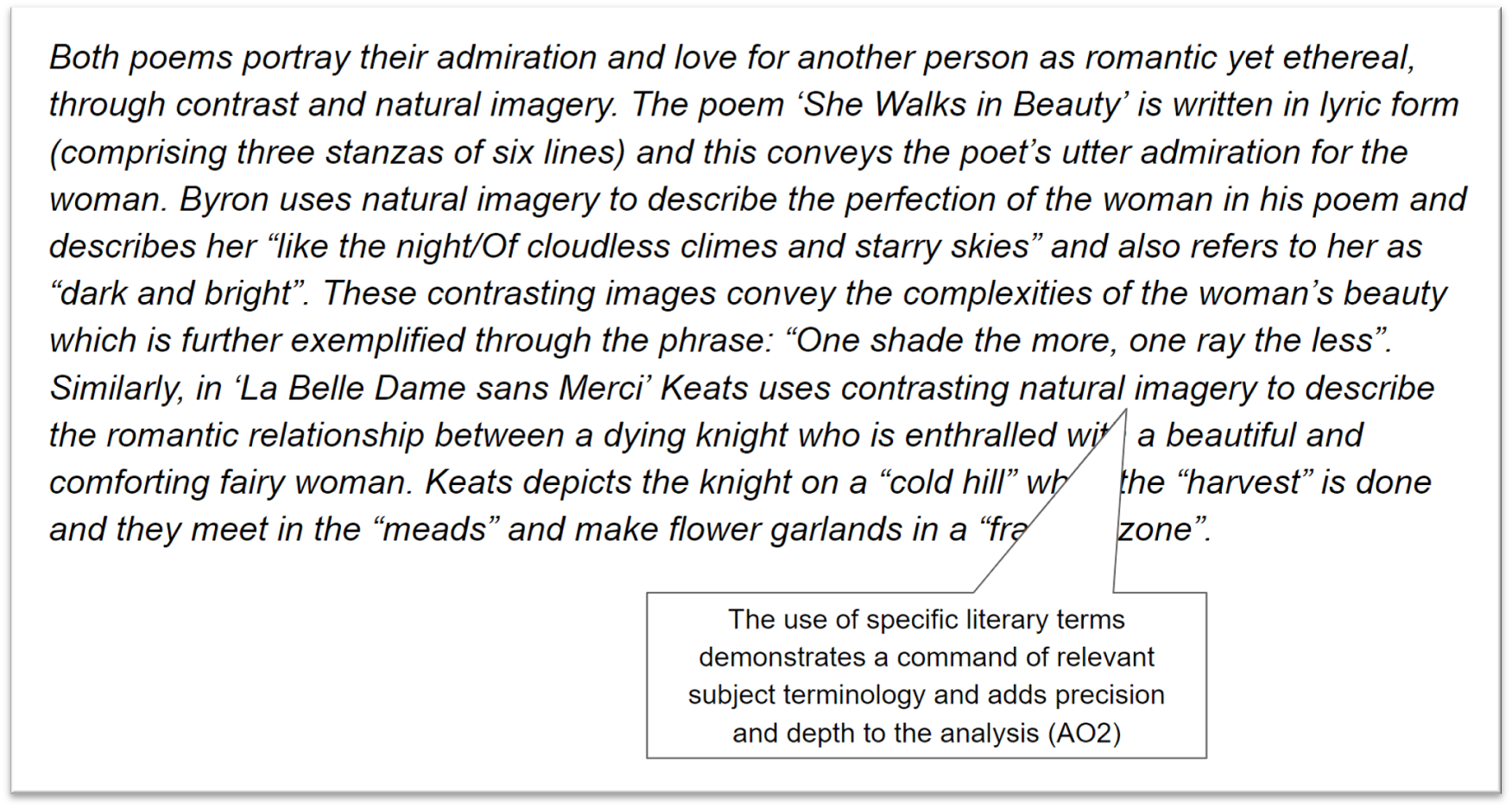|
In both ‘She Walks in Beauty’ by Lord Byron and ‘La Belle Dame sans Merci’ by John Keats the poets explore themes of admiration for another person, by presenting relationships in classical and romantic terms. However, while Byron’s presentation of love has a peaceful resolution, Keats presents a more melancholy version of a relationship.
Both poems portray their admiration and love for another person as romantic yet ethereal, through contrast and natural imagery. The poem ‘She Walks in Beauty’ is written in lyric form (comprising three stanzas of six lines) and this conveys the poet’s utter admiration for the woman. Byron uses natural imagery to describe the perfection of the woman in his poem and describes her “like the night/Of cloudless climes and starry skies” and also refers to her as “dark and bright”. These contrasting images convey the complexities of the woman’s beauty which is further exemplified through the phrase: “One shade the more, one ray the less”. Similarly, in ‘La Belle Dame sans Merci’ Keats uses contrasting natural imagery to describe the romantic relationship between a dying knight who is enthralled with a beautiful and comforting fairy woman. Keats depicts the knight on a “cold hill” when the “harvest” is done and they meet in the “meads” and make flower garlands in a “fragrant zone”.
Both poems can also be considered classical and traditional in their presentation of romance and admiration. Byron’s speaker displays his admiration as he idealises his beloved’s beauty and purity. The speaker describes her as “So soft, so calm, yet eloquent” and that she has “smiles that win”, speaks of “goodness” and has “serenely sweet” thoughts. The speaker in Keats’s poem also presents a similar classical depiction of romance. The speaker describes the female figure in ‘La Belle Dame sans Merci’ as a typical damsel in distress at times, such as in the line “she wept and sighed full sore”. The object of the speaker’s love in Keats’s poem is a typical female character in Romantic poetry: she is described as “Full beautiful” and her “hair was long” and she expresses her feelings for the knight: “‘I love thee true’”, which again shows a mutual admiration based on traditional gender roles.
Byron’s poem is written in lyric form comprising three stanzas of sestets which could also be used to convey the poet’s admiration for the woman. There is a regular rhythm and a regular rhyme scheme, perhaps suggesting the regularity of the poet’s walk and the woman’s perfection. Furthermore, the use of enjambment suggests that the poet cannot pause for breath when showing his admiration for the woman. In contrast, Keats writes in the form of a medieval ballad which is written in 12 quatrains. The repetition of lines describing the knight alone on a hill in the first and last stanzas creates a cyclical story that is not resolved. Keats takes the reader through an engaging story in keeping with the oral traditions of a ballad and uses this to convey ideas about acceptance and inevitability. Both poets, Keats and Byron, were Romantic poets and the poems were written in the same decade (1814 and 1819). Romantic poets were fascinated by the mysterious as well as the experience of the sublime – the feeling of being overwhelmed by something greater than oneself. In Keats’s poem, the supernatural element is evident in the mysterious nature of the woman who bewitches the knight. Both poets use a regular rhythm and rhyme scheme and both draw on the Romantic themes of heartfelt emotions and nature.
However, while 'She Walks in Beauty' ends with a peaceful resolution, 'La Belle Dame sans Merci' has a tragic conclusion that presents desire and admiration as dangerous. This is evident as Byron’s poem has a regular structure with a ABABCC rhyme scheme across stanzas to show a calm, reflective speaker. However, Keats’s poem raises darker themes in the disrupted rhythm of the lyrical ballad. The alternating rhyme creates a flowing narrative at times while other lines, such as with “brow” and “rose”, create an ominous tone. Moreover, Byron uses iambic tetrameter to create a regular and controlled rhythm to convey a positive tone. The poem ends with an exclamation of joy: “A heart whose love is innocent!” In contrast, in Keats’s poem, the regular rhythm is disturbed with short lines like “And no birds sing”. This line ends the poem with a dark conclusion, the knight alone and dead. Keats uses caesura and exclamations to present warnings, such as in “—Ah! woe betide!—”. While Keats’s Romantic poem dwells on the brief love of a dying knight, Byron’s poem is a universal expression of admiration and joy.
In their poems, both Byron and Keats explore themes of admiration for another person by presenting relationships as classical and traditional. However, while Keats's poem tells a melancholy tale about a strange and ethereal fairy, Byron’s poem is more like a tribute to a beautiful woman.
|







